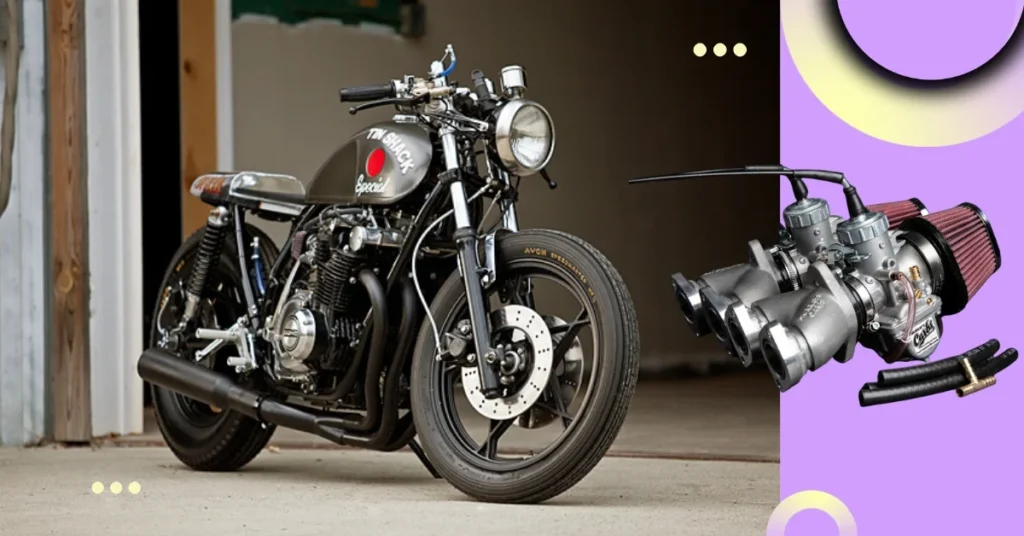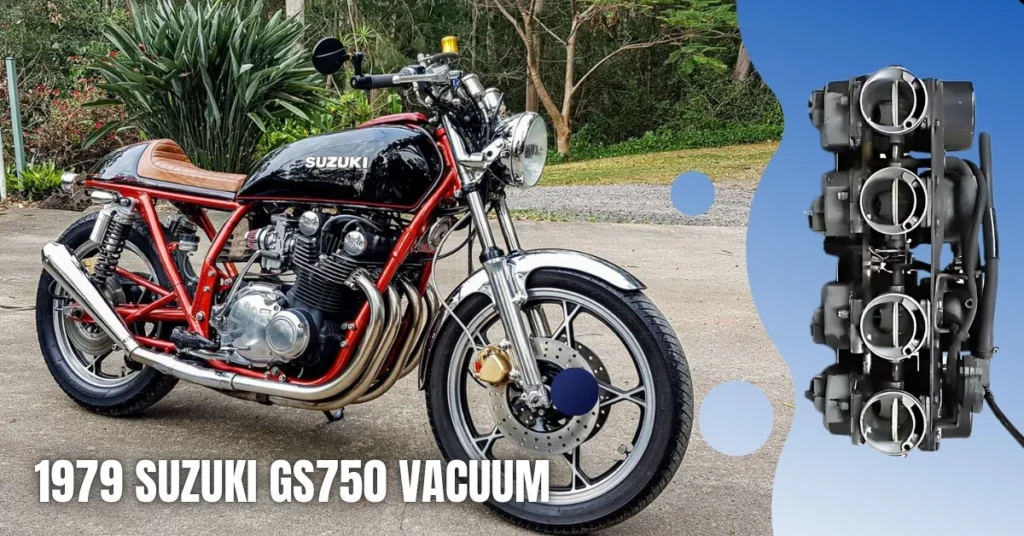Have you ever noticed your Suzuki GS750 idling roughly or losing power unexpectedly? One common culprit could be the vacuum line routing—a critical, yet often overlooked, part of your motorcycle’s functioning. If the vacuum lines are not properly routed, they can lead to a host of issues such as stalling, poor fuel efficiency, or even total engine failure. But don’t worry! This blog post will guide you step-by-step through the process of correctly 1979 Suzuki Gs750 Vacuum Line Routing.
Proper vacuum line routing is essential for smooth operation, and by following these instructions, you’ll be well on your way to ensuring your bike runs like it just rolled off the factory floor.
Overview of the 1979 Suzuki GS750’s Vacuum System

The 1979 Suzuki GS750 uses a vacuum system to help regulate fuel flow and ensure proper carburetor operation. Understanding this system is crucial to ensuring your bike runs smoothly.
Introduction to the Vacuum System
The GS750’s vacuum system involves a series of hoses that link the carburetors, intake manifolds, and the vacuum-operated petcock (fuel valve). The system uses engine vacuum (the difference in pressure created by the movement of the pistons) to control the fuel delivery from the gas tank to the engine. When the engine is running, it generates enough vacuum to open the petcock, allowing fuel to flow.
Key Components
- Carburetors: The GS750 has four carburetors that work together to mix fuel and air in the right proportions.
- Vacuum-operated Petcock: The petcock opens and closes the fuel flow based on vacuum pressure, preventing fuel leaks when the bike isn’t running.
- Intake Manifolds: These are the ports where the vacuum lines connect to the carburetors.
Vacuum Line Diagram
Having a diagram handy is invaluable. Below is an overview of the vacuum system layout:
- Petcock to Intake Manifolds: The primary vacuum line connects the petcock to a port on the intake manifold.
- Carburetors to Emission Control Ports: If your bike has emission controls, these lines will also need proper routing.
Tools and Materials You’ll Need
Before diving into the project, gather all the necessary tools and materials to avoid running back and forth between tasks.
Basic Tools
- Phillips and Flathead Screwdrivers: For loosening clamps and removing panels.
- Pliers: Needle-nose pliers work best for gripping and securing vacuum lines in tight spaces.
- Razor Blade/Utility Knife: In case you need to trim the vacuum hoses to the right length.
Required Materials
- Replacement Vacuum Hoses: Make sure they are the correct diameter and material.
- Hose Clamps: To secure the vacuum hoses tightly (if your system uses them).
- Vacuum Gauge (optional): Helps in testing vacuum pressure after installation.
- Lubricant (optional): This can make it easier to fit the hoses over the ports without damaging them.
Safety Equipment
- Gloves: To protect your hands from sharp edges and chemicals.
- Safety Glasses: Always a good idea when working on fuel systems.
Step-by-Step Vacuum Line Routing Process
Now that you understand the system and have your tools ready, let’s get into the actual process of routing the vacuum lines.
Step 1: Identifying the Components
Start by locating all the vacuum ports on your bike. You’ll need to find:
- The petcock (usually located under the fuel tank).
- The vacuum ports on each of the carburetors.
- The intake manifolds will be connected to the carburetors.
Refer to your vacuum system diagram if needed.
Step 2: Removing Old or Faulty Lines
Carefully inspect the current vacuum lines for any signs of wear and tear. Old hoses may be brittle, cracked, or clogged. Here’s how to remove them:
- Loosen any clamps or retainers holding the hoses.
- Gently pull the hoses off their connections. If they are stuck, you can use a razor blade to cut them off carefully.
- Check for blockages or cracks in the old hoses, as these can cause vacuum leaks.
Step 3: Cutting and Preparing New Vacuum Lines
Measure the old vacuum lines to cut the new ones to the appropriate length. Be careful not to make them too short (which can cause stress on the connections) or too long (which can cause kinks).
- Use a utility knife or razor blade to cut clean, straight edges on the hoses.
- Test-fit the hoses on the ports before securing them.
Step 4: Connecting the Vacuum Lines
Now it’s time to route the new vacuum lines:
- Petcock to Intake Manifold: Connect one end of the vacuum hose to the petcock and the other to the appropriate intake manifold port. Ensure there are no kinks or sharp bends in the hose.
- Carburetor Ports: Depending on the model, connect the remaining hoses from the carburetor vacuum ports to their corresponding ports.
- Clamp and Secure: Use hose clamps to secure the hoses in place, especially if they are loose or the fit seems imperfect.
Step 5: Testing the Vacuum System
After everything is in place, test the vacuum system to ensure there are no leaks:
- Start the engine and listen for any signs of vacuum leaks (whistling or hissing sounds).
- Use a vacuum gauge to check for proper pressure.
- Check if the petcock is functioning correctly by ensuring fuel flows when the engine is running and stops when it’s off.
Troubleshooting Common Issues
Even after completing the installation, you may encounter some issues. Here’s how to troubleshoot:
Symptoms of Incorrect Vacuum Line Routing
- Rough Idling: If your bike idles erratically, you may have a vacuum leak.
- Engine Stalling: The bike could stall when stopping if the vacuum system isn’t functioning properly.
- Fuel Starvation: If the petcock doesn’t receive enough vacuum, it won’t allow fuel to flow.
Diagnosing a Vacuum Leak
- Visual Inspection: Check all connections for loose hoses or cracks.
- Vacuum Gauge: This tool ensures vacuum pressure is consistent across all ports.
- Spray Test: Spray a small amount of carb cleaner around the vacuum hoses. If the engine revs, you’ve found a leak.
Fixing Common Problems
- Re-route any hoses that seem misplaced or kinked.
- Tighten loose clamps.
- Replace any hoses that are cracked or leaking.
Maintenance Tips for Vacuum Lines
Maintaining your vacuum lines is essential for long-term bike performance.
Regular Inspection Schedule
Check your vacuum lines for wear and tear every six months, or sooner if you notice performance issues.
Signs That Vacuum Lines Need Replacement
- Cracking or brittleness.
- Hardening of the hose material.
- Discoloration or leaking fuel/vacuum.
Prolonging Vacuum Line Life
- Store your bike in a cool, dry place to prevent premature degradation of rubber hoses.
- Use high-quality vacuum hoses that are designed to last longer.
Additional Modifications and Upgrades
If you’re serious about performance and longevity, consider upgrading or modifying your vacuum system.
Upgrading to Higher Quality Vacuum Hoses
Modern silicone vacuum hoses last longer and are more heat-resistant than standard rubber hoses.
Adjusting the Vacuum System for Performance Tuning
Proper vacuum line routing helps in carburetor tuning. After ensuring your vacuum system is set up correctly, you can fine-tune your carburetor for optimal performance.
Conclusion
Vacuum line routing may seem like a small detail, but it’s crucial to the overall performance of your Suzuki GS750. Following the steps in this guide ensures that your bike’s vacuum system is operating correctly, leading to better fuel efficiency and smoother operation. Do you have questions or tips from your own vacuum line routing experiences? Feel free to share them in the comments below!
With a little effort and the right tools, you can confidently take on this project and keep your classic bike running like a dream.
FAQs
Why is vacuum line routing important on the Suzuki GS750?
Correct vacuum line routing ensures proper fuel flow, carburetor performance, and engine operation.
Can incorrect vacuum line routing damage my engine?
Yes, incorrect routing can lead to fuel starvation or vacuum leaks, which can cause engine damage over time.
How do I know if I need to replace my vacuum lines?
If you notice cracks, stiffness, or performance issues like rough idling, it’s time to replace them.
Can I use generic vacuum lines from an auto parts store?
Yes, as long as they are the correct size and material, but using hoses specifically designed for motorcycles is recommended.

